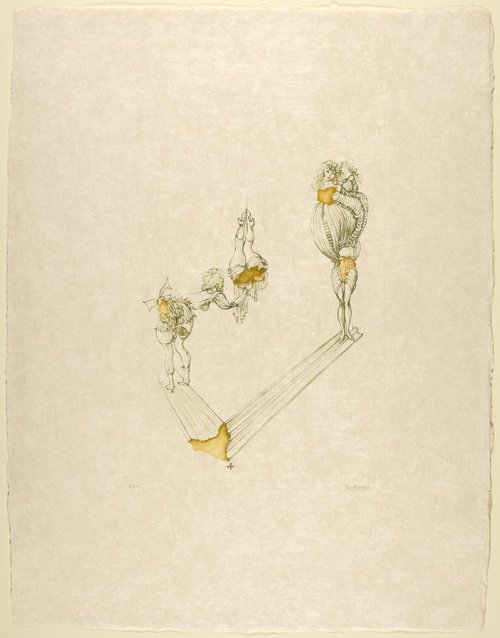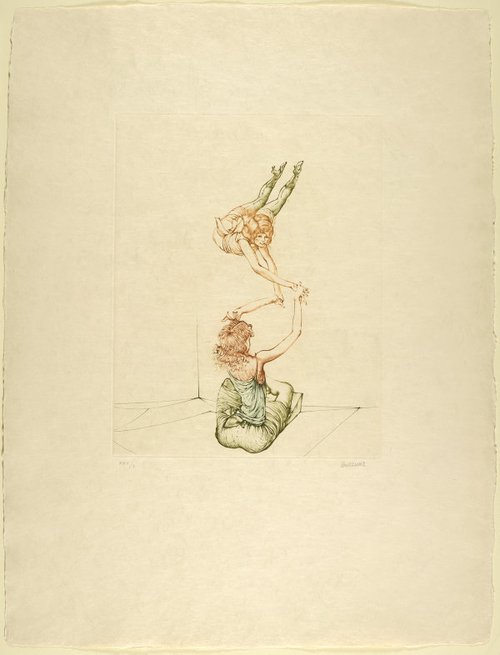-
Details
- Other Title
- The half doll
- Date
- 1971
- Media category
- Sculpture
- Materials used
- wood, paint and assemblage
- Dimensions
- Doll: 90.0 cm (height)
- Signature & date
Signed on palm of hand, black fibre-tipped pen ".../ Bellmer". Not dated.
- Credit
- Purchased 1996
- Location
- Not on display
- Accession number
- 89.1996
- Copyright
- © Estate of Hans Bellmer/ADAGP. Copyright Agency
- Artist information
-
Hans Bellmer
Works in the collection
- Share
-
-
About
Hans Bellmer’s influence straddles several generations. He became a member of the surrealist group in the early 1930s and continued drawing and creating sculptures into the 70s, including this work completed in 1971. The subject matter of his art can be traced back to his childhood, when he had erotic fantasies about his young cousin Ursula. Later he was to be greatly influenced by ‘The tales of Hofmann’,1 which revealed to him a world in which childhood and art were linked. Bellmer began making surrealist drawings and sculptures while he was still living in Germany although he was rarely able to show them, and in 1935 created 18 photographs for the surrealist magazine ‘Minotaure’. Fleeing the attention of the Nazis, he took up residence in France in 1938 but was interned along with Max Ernst until 1940. Even in France Bellmer’s work was beyond most public limits and found its place in the experimental publications and happenings organised by the surrealists. His themes were often highly erotic, exploring the inside and outside of the body, exaggerating genital areas and violently distorting the human form. A number of writers of the day included his images in their texts, including Paul Eluard and notably Georges Bataille, who commissioned Bellmer to provide illustrations for his influential book ‘Histoire de l’oeil’ (the story of the eye).
While in his drawings Bellmer was free to imagine all manner of contortions, his photographs depended on the poses he could contrive with his sculpted dolls, or poupées. These he constructed to allow a multitude of variations. His first version was more rigid; his second had a fully articulated body and included a spherical belly around which he could arrange up to four legs, four bulbous breasts, an upper torso, three pelvises, a pair of arms and the recycled head and hands of his first doll. It is this second version that most often features in his photography. By dressing the dolls in girls’ dresses with large ribbons in their hair and schoolgirls’ shoes, he added further variation. The figures could then be posed in bizarre situations on stairways and beds, or against trees, often as if in bondage.
‘La demie poupée’ is simpler in that it has only one leg, one arm and one breast. Like his earlier dolls, it wears an enormous bow at the back of its bald head, a white sock and ‘Mary-Jane’ shoe. Possibly, its most bizarre feature is its head, which is configured more like the head of a penis or the cleft of a buttock – only the small puckered mouth confirms that it is at least part human.2 These gender mutations are typical of Bellmer’s work but they also find contemporary resonance with the abject objects and images created by artists such as the Chapman brothers and Cindy Sherman, and aspects of works by Francesco Clemente and Dennis Del Favero.
1. Jacques Offenbach’s play ‘The tales of Hofmann’ directed in 1931–32 by Max Reinhardt. In the play the protagonist falls hopelessly in love with an automaton.
2. See Susan Best, ‘Just looking? The body, the gaze, and syncope’, in ‘Body’, AGNSW, Sydney 1997, p 89© Art Gallery of New South Wales Contemporary Collection Handbook, 2006
-
Exhibition history
Shown in 4 exhibitions
Body, Art Gallery of New South Wales, Sydney, 12 Sep 1997–16 Nov 1997
The surreal aesthetic, Art Gallery of New South Wales, Sydney, 28 Jul 2007–14 Oct 2007
2008 Biennale of Sydney: revolutions-forms that turn, Art Gallery of New South Wales, Sydney, 18 Jun 2008–07 Sep 2008
Soft Sculpture, National Gallery of Australia, Canberra, 24 Apr 2009–19 Jul 2009
-
Bibliography
Referenced in 8 publications
-
Art Gallery of New South Wales, Art Gallery of New South Wales annual report 1998, 'Exhibitions', pg. 20-24, Sydney, 1998, 22 (colour illus.).
-
Marie-Lauré Bernadac, Fémininmasculin : le sexe de l'art, Paris, 1995, 161. cat.no. 220, Exhibition at the Centre national d'art et de culture Georges Pompidou, 24 Oct 1995 - 12 Feb 1996. Not AGNSW doll another doll from the edition of nine was exhibited.
-
Anthony Bond, Contemporary: Art Gallery of New South Wales Contemporary Collection, 'Imagining the body', pg.246-289, Sydney, 2006, 248, 252, 253 (colour illus.).
-
Anthony Bond, Body, 'Embodying the Real', pg. 11-80, Sydney, 1997, 65, 66 (colour illus.), 89. figure 92, cat.no. 12
-
Musée d'art et d'histoire, Geneva, Les figures de la liberté, Geneva, 1995, book spine (illus.), 76 (illus.). cat.no. 18, illustrations are not of AGNSW doll, they are of another work from the edition of nine. This doll has a long sock and different shoe and the date 1939-45.
-
Leon Paroissien and Dinah Dysart (Editors), Art and Australia (Vol. 34, No. 3), 'Exhibition Commentary: recent aquisitions from State Galleries', pg.129, Sydney, Jan 1997-Mar 1997, 129 (colour illus.).
-
Lucina Ward, Soft sculpture, 'SOFT sculpture, modernity, minimalism and the body', pg.5-25, Canberra, 2009, 9 (colour illus.).
-
Peter Webb and Robert Short, Hans Bellmer, 'Paris, 1955-75', pg.223-268, London, 1985, 263. This chapter refers to the nine versions of 'La demie poupée', editions are not individually mentioned.
-




